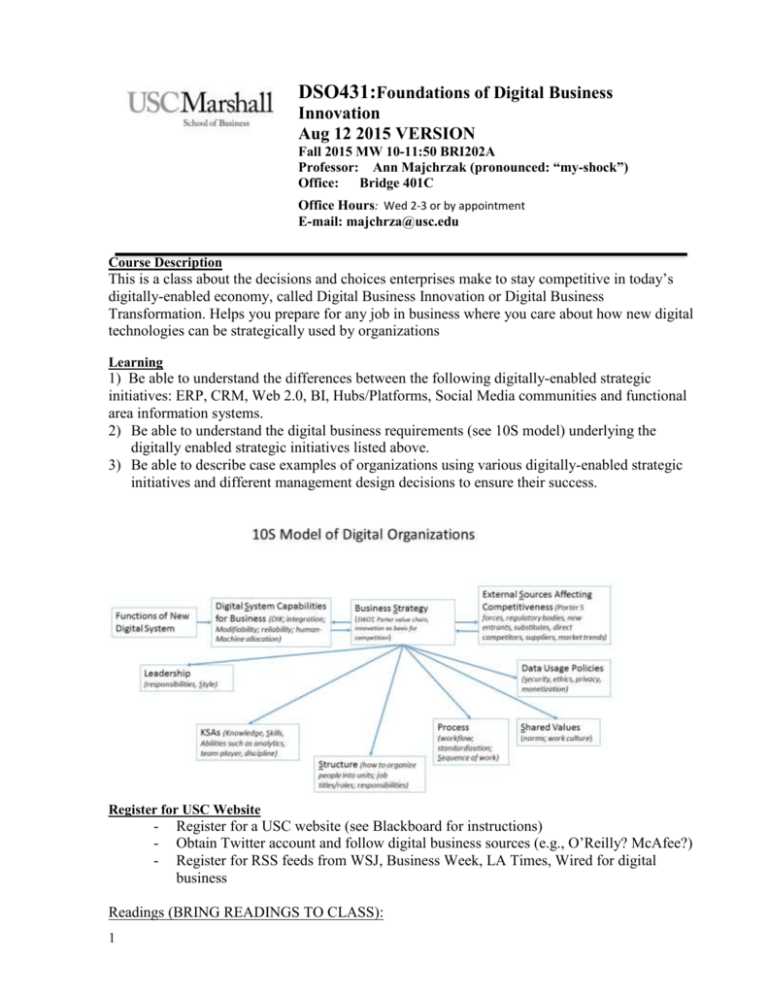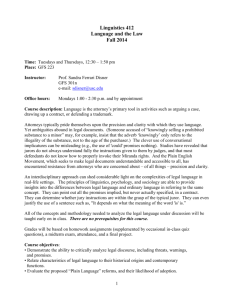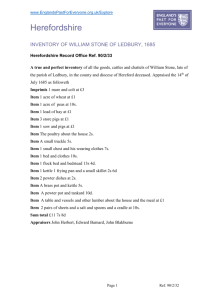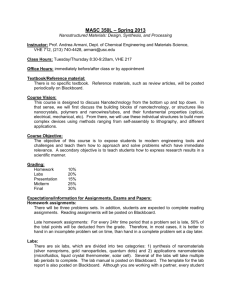Marketing Fundamentals
advertisement

DSO431:Foundations of Digital Business Innovation Aug 12 2015 VERSION Fall 2015 MW 10-11:50 BRI202A Professor: Ann Majchrzak (pronounced: “my-shock”) Office: Bridge 401C Office Hours: Wed 2-3 or by appointment E-mail: majchrza@usc.edu Course Description This is a class about the decisions and choices enterprises make to stay competitive in today’s digitally-enabled economy, called Digital Business Innovation or Digital Business Transformation. Helps you prepare for any job in business where you care about how new digital technologies can be strategically used by organizations Learning 1) Be able to understand the differences between the following digitally-enabled strategic initiatives: ERP, CRM, Web 2.0, BI, Hubs/Platforms, Social Media communities and functional area information systems. 2) Be able to understand the digital business requirements (see 10S model) underlying the digitally enabled strategic initiatives listed above. 3) Be able to describe case examples of organizations using various digitally-enabled strategic initiatives and different management design decisions to ensure their success. Register for USC Website - Register for a USC website (see Blackboard for instructions) Obtain Twitter account and follow digital business sources (e.g., O’Reilly? McAfee?) Register for RSS feeds from WSJ, Business Week, LA Times, Wired for digital business Readings (BRING READINGS TO CLASS): 1 Reading of all material including PPTs and jotted down answers to questions is due by date on syllabus. You should CRITICALLY THINK about the reading, i.e., learn the content, then be able to describe the content in your own words, with the examples described in the text, details, being able to argue pros and cons. Bring reading material to class on day reading due since we’ll be referring to it. Text (in addition to Blackboard): Rainer, Prince & and Cegielski, Introduction to Information Systems: Supporting and Transforming Business, 2014 5th Edition. Wiley Publ. You may go to coursesmart com and use the e-book version. Or go to Marshall Homer, which will direct you to proquest.safaribooksonline.com) No other editions permitted. Prerequisites and/or Recommended Preparation: none Grading Policies: Grading is based on the following: Participation (includes meeting attendance requirements) 10% Case Presentation/Discussions (conducted in groups of 2-3) 15% Case Writeup (different group of 2-3) 15% Final Individual Take-home exam 30% 3 glossary quizzes to reward those keeping up with reading (10% each) 30% Final grades represent how you perform in the class relative to other students. Your grade will not be based on a mandated target, but on your performance. Historically, the average grade for this class is about a (B). Three items are considered when assigning final grades: 1. Your average weighted score as a percentage of the available points. 2. The overall average percentage score within the class. 3. Your ranking among all students in the class. In-Class Expectations: In the spirit of Marshall’s move to experiential and critical thinking experiences in the classroom, I will try this year to do minimal lecturing. Instead, I will provide you with the PPTs in advance and expect you to review them along with the reading. If you don’t have the time to do that, please don’t come to class and drag down the discussion. If I determine you haven’t done the reading, I will politely and quietly ask you to leave because your lack of participation harms the general discussion. I have identified discussion questions that we will focus on during the class. Please come prepared to: a) ask substantive questions you might have about the PPTs, and b) enter into a discussion about the questions. Participation Grade: A high Participation Grade based on: A) Lack of absences: Being absent or tardy by more than 5 minutes for more than 1/3rd of the classes (10) for any reason (recruiting, illness, etc.) will lead to an automatic Fail in the class, regardless of exam grades and regardless of reason. You need not inform me if you’re going to be absent since it doesn’t matter. Not being in the classroom is not being in the classroom. Being absent or tardy between 5-9 classes will lead to an automatic reduction of a grade in your final grade. B) NOT sitting at back of the wall. C) following the technology policy (see below) D) Staying on task during breakout sessions. In addition, for each class the following points are assigned: Brought in material from outside reading illustrating the part of the 10S model we’re discussing:+1. Helping others understand some concept without 2 making them feel bad: +1. Offering a mini-presentation on a topic of interest related to class material (see me beforehand): +2. Asking questions indicating you’ve read the material but want to take the concept further or need clarification: +1. Showing to me that you haven’t read the material by not knowing the material: -2. See more details on Blackboard for Participation Grading Rubric. A participation grade will be assigned for the semester at the end of the semester based on your full semester’s participation. Case Presentation/Discussion Sessions and Writeups: First read Instructions for Doing a Case Analysis posted in Blackboard. You will need to select (and signup) for 2 cases: one which you will present as part of a 2-3 person group, and one which you will writeup (as part of a DIFFERENT 2-3 person group). The cases are due at the start of the class in which they will be discussed. The class must distribute themselves across the cases, so signup on Blackboard’s Discussion Forum no later than September 9th to ensure that all cases have one presentation group and one writeup group associated with it. Some of the cases are pre-written (PW) and you add material to update; other cases you will need to find the material to develop (Find&Develop-FD) the case. Everyone should sign up for 1 PW (either as case writeup or presentation) in groups of 2. Everyone should also sign up for 1 FD case (either as case writeup or presentation) in groups of 3. The cases are: Motorola (PW) Western Digital (PW) P&G’s Open Innovation (PW) Data Monetization at Drug Co (PW) Cloud Computing at Bayer (PW) Volvo’s Connected Car (PW) Hummel’s Omnichannel E commerce (PW) Enterprise’s Hub (PW) Threadless’ use of Web 2.0 (FD) Kaiser Permanente’s use of social media (FD) Huffington Post’s C2C platform (FD) Salesforce’s use of App Exchange (FD) If you would like to present a different case, this would be part of your participation grade (+2) and not this grade. For all cases, there are 3 learning objectives: 1) understand in immense detail for each element in the 10S model, what the business did to succeed at its digital innovation; 2) what specific practices with respect to the 10S model could be applied to other businesses implementing a similar digital innovation and MIGHT NOT apply under certain circumstances (if you can organize your thoughts into a framework such as a 2x2 indicating when these practices apply and when they don’t apply, that would be best, rather than just a list); and 3) given today’s market, competitors, and current state of the company, what should the company consider as a next step for digital innovation (this 3rd objective will require researching library resources). For each case, organize your work by: I. Background of case (market the company is in, competitors, facts about the company (either written in the case or obtained from library resources) II. Address leaning objective #1: Describe the elements in the 10S model, alignments among the 10S model elements, what changes were made for digital innovation, and evidence that changes were successful. Details! 3 III. Address learning objective #2: what practices could be applied to other companies. Be specific with examples of practices and examples of firms. Frameworks would be best. IV. Address learning objective #3 citing sources you have found as footnotes. If terms are used in the case that we haven’t covered in class, they should be researched and defined in the context in which they’re used (not just a restatement of a dictionary definition). When you are WRITING UP the case, all the above will be a 3-page single-spaced, single-sided document that will be handed in physically at BEGINNING OF CLASS in which case is discussed AND uploaded electronically to blackboard BEFORE BEGINNING OF CLASS. Once class has started, no case write-ups will be accepted AT ALL; no exceptions. Grading Rubric will be: accuracy, comprehensiveness for each learning objective, reliability of sources, specificity and critical thinking in your answers to Learning Objective #1&#2, innovativeness of your answer to Learning objective #3. Case analysis based on a Critical Thinking Rubric which is posted in Blackboard. When you are presenting/leading a class discussion the case, a case outline is due at beginning of class. Expect to use up to 30 minutes of class time including student discussion. The outline will have: your ANSWERS to the above learning objectives PLUS questions that you will use to prompt class discussion. The presentation should unfold in the following way: 1) you present the background of the case (if there are terms not covered previously in class, define them In CONTEXT; 2) you then walk the students through learning objective #1, getting the students to provide as much input as possible, and when something isn’t covered by the students, prompt them as to why something else is needed – all the while you are writing this material up on the board. 3) you then ask the students to provide examples of when each of the practices depicted in the model could be used elsewhere, and when they couldn’t (for learning objective #2 – if there is a debate, encourage it to play out), and 4) you then lead a discussion about possibilities (perhaps you have them look at a gartner hype cycle to stimulate ideas). The outline you turned in at beginning should have had all your answers on it. Grading Rubric for Presenting/Leading: Same as Case Writeup PLUS ability to engage the students. See Grading Rubric for Team Presentations on Blackboard. When cases are being presented, even if it’s a case you don’t have due, you are still required to read it and think about it, since you will need to understand it for the Final. Individual Take Home Exam (Hard copy due Dec 14, 10AM in Bridge 400; upload to BB by same time) Lateness graded down significantly. 5 pages single space. Plagiarism=Fail. This class on Foundations of Digital Business Innovation was intended to help you understand what is required to make a digital business successful and to continuously innovate digitally. We will have covered many different digital systems, business strategies, and the need to ensure alignment with the 10S Model of Digital Innovation to ensure business success. You are now ready to prepare a research paper that explains what is digital business innovation and what is the specific knowledge needed to do it well. You decide on how you want to organize the paper, but it should, at a minimum, describe specific practices that have been covered in the 10S Model that foster successful digital innovation, which of these practices need to be used in certain contexts and not others, and which are quite unique to specific types of digital innovations. You should use the example cases discussed in class or reading (NOT others) and information you obtain from reliable sources, for example, about the pace of technology change in the business world, or pace of market changes. You will be graded with the following rubric: 4 - Are sources from Marshall’s electronic library of Company and Business Resources, Gartner, Forrester, etc. and clearly footnoted when used. Are any depictions of the “Business world” sourced Do you have a detailed understanding of specific practices discussed (or is it generic) Is your inclusion of cases reflecting this deep understanding Do you understand the contexts in which specific practices should NOT be used Have you been able to go beyond what was discussed by introducing new frameworks or new information gleaned from your research Are you able to integrate across material covered in class Are you able to engage with material in an objective research fashion, not as an advocate or critic. The Final Paper, per USC policy, will be due on the final exam due date. It is USC policy to not allow for finals to be taken at any other time than the scheduled time, with exceptions granted only by the Department Chair and Dean. If you have need for an exception please consult them directly. This paper, if done well, will be useful as a sample of your digital innovation knowledge for recruiters, so add it to your website and Linked In profile Glossary Quizzes There will be three. This is to reward those who are studying as they are reading, taking the glossary of terms seriously, so they can use these digital innovation terms fluidly in conversations. This exam will be multiple choice, and purely rote memory. It will cover the material in the text since the last exam. There are no makeups for the glossary quizzes. You have been given adequate notice of when quizzes will occur; there is no makeup permitted. COURSE CALENDAR/READINGS/CLASS SESSIONS # Date Topic Preparation Due by Date BB=reading is on Blackboard; otherwise reading is in Text or with Marshall Electronic Resources BEGIN SIGNING UP FOR CASES 1 M Overview of class, Syllabus, 8/24 Sign up for Twitter RSS, Website 2 W 10S Model of Digital Business using Ch 1 and PPTs; overview use of 10S model to 8/26 Baxter; Digital Innovation analyze Warby-Parker case based on the minimal disruptions and implications using information on case . What is the digital Marshall Electronic Resources; innovation in Warby Parker? characteristics of digital Innovation Be able to address: Baxter case Qs1-3; Disc Q2-5,8 (DIK, integration, modifiability, Be able to access the “Gartner Agenda Overview reliability, human-machine for Digital Business 2015” in my marshall library allocation; not = functions) resources M Business Strategy and Processes as Ch 2 and PPTs 8/31 part of the 10S model Qs for Chevron case (section 2.2). Qs in Section 2.5; Disc Qs: 2-6, 13,14 Be able to apply business processes, Porter’s value chain, and the strategy to focus on innovation to Warby-Parker’s use of digital innovation 3 5 4 W External Forces as part of the 10S 9/2 Model M 9/7 W 9/9 M 9/14 no e W 9/16 5 6 7 LABOR DAY ERP PPTs and Ch 10 Discussion #6; Problem-Solving Q#2 Effect of ERP on a digital business Motorola Case.of ERP Implementation Be able to address the 3 learning objectives Effect of ERP on a single unit: customer service center: SAP Lab 8 M Business Intelligence (BI) and Big 9/21 Data with ERP 9 Use of Big Data for Decisionmaking W 9/23 No e 10 M 9/28 No e Data Usage Policies: Ethics and Privacy 11 W Data Usage Policies: Security 9/30 6 Look up SWOT. Be able to apply to WarbyParker to explain why they turned to digital innovation Ch 2. Understand Porter’s Competitive Forces, Section 2.3 (Business Pressures). Collect info on Uber and complete a detailed analysis of 2 10S Model elements: Business Strategy and External Forces ALL CASE SIGN UPS COMPLETED After the lab, be able to provide a detailed analysis of how a customer service center using SAP would need to change if SAP was the digital innovation of the firm Gartner: “Reengineering the Digital Workplace: Don’t Automate, facilitate” GLOSSARY QUIZ#1 PPTs and Ch 12 and Ch 5: 5.1, 5.2, 5.5 Ch 2: Closing Case: IBM Watson (Qs1-4) Probl-solving #2 in Ch 12, & Disc Qs in Ch 5 Be able to complete the 10S model if the digital innovation was the use of BI with Big Data Evidence-Based Management at Western Digital Case. Be able to address the 3 learning objectives Consider Gartner “Hype Cycle for Big Data 2014” Ch 3 and PPTs Identify from text a list specific policies for employees that should be in place with digital innovations Compare them to policies you find on the internet for 3 companies. Apply these policies to the 3 text cases of Target, a company who has an employee posting something on Wikileaks, and Pinterest.. What should the company do about each case? Prepare for a debate on the following question: Is Google’s technology violating privacy policies of restaurants? Should they change the technology so it doesn’t violate privacy policies? Winner is judged based on real data provided. Ch 4 and PPTs: Identify from text a list of specific policies that companies should institute to ensure security. 12 M 10/5 No e 13 W 10/7 14 M 10/ 12 15 W 10/1 4 16 M 10/ 19 17 W 10/ 21 18 M 10/ 26 19 W 10/ 28 20 M 11/2 21 W 11/4 22 M 11/ 9 23 W 11 /11 VET 7 Compare these policies to those you find on the internet for 3 companies. Data Monetizing Data Monetizing at Drug Co Case. Be able to address the 3 learning objectives Forrester “It’s time to Take Your Data to Market” Knowledge Sharing: Fast Ch 5, Section 5.6 and PPTs; be able to complete knowledge-sharing website creation 10S Model for Knowledge Sharing as a Digital as a Digital Innovation for firms to Innovation make better use of employee Disc qs: 8,9 knowledge. Wayne Wilmeth Cloud Computing Tech Guide p. 466-485 and PPTs Salesforce.com lab Review Amazon’s cloud computing offerings; How would the 10S Model look like if SaaScloud computing was a Digital Innovation Forrester: “The Cloud Computing Playbook for 2015” Cloud Computing Cloud Computing at Bayer. Be able to address the 3 learning objectives Gartner: “Hype Cycle for Cloud Computing” GLOSSARY QUIZ #2 Web 2.0 Ch 9 Disc Q 1-9; Problem Solving Qs: 5-7 Web 2.0 in Health care Social Media Use at Kaiser Permanente. Be able to address the 3 learning objectives Web 2.0 in Journalism Huffington Post’s Customer-to-Customer Portal. Be able to address the 3 learning objectives Web 2.0 as a platform for a creative Threadless case. Be able to address the 3 learning retail company objectives. B2C Ecommerce Multi-channel conflict with B2C B2B Ecommerce: Exchanges and Ecosystems Simple B2B Exchanges Chapter 7: 7.1 and 7.2, and Section 1.7.2. Disc Qs: 1, 7, 9 and check google to learn about bitcoin and which companies take it. Forrester: “Using the power of B2B Digital Ecosystems” Fill in the 10S Model for B2C Hummel Omnichannel case. Be able to address the 3 learning objectives. Ch 7: 7.3 Disc Qs: 4. Learn about Covisint: what does it provide as an exchange Salesforce.com’s AppExchange. Be able to address the 3 learning objectives as they depict what Salesforce.com has to do to make AppExchange successful. 24 M Challenges of B2B Exchanges 11/ staying digitally current 16 25 26 27 28 Capital Group: speakers “EAI vs SOA vs ESB” on BB “SOA Definitions and Solutions” on BB And PPTs. Look up Capital Group to know what it does. Complete an initial 10S model of them W More complex B2B exchanges Enterprise Rent-a-car Exchange case. Be able to 11/ address the 3 learning objectives 18 GLOSSARY QUIZ #3 M Open Digital Innovation to outsider P&G’s Open Innovation case. Be able to address 11/ ideas the 3 learning objectives. 23 Forrester: “A systematic approach to Open Innovation Strategy” M Open Digital Innovation: beyond Volvo’s Connected Car case. Be able to address 11/3 just R&D the 3 learning objectives when the digital 0 innovation is opening up development to a connected ecosystem W Putting it all together Come with suggestions on how to integrate the 12/2 material 12 FINAL EXAM Final paper to be /14 turned in by 10AM to Bridge 4th 8AM floor secretary MARSHALL GUIDELINES Add/Drop Process If you are absent six or more times prior to the last day to withdraw from a course with a grade of “W”), I will ask you to withdraw from the class by that date. These policies maintain professionalism and ensure a system that is fair to all students. Technology Policy Laptop and Internet usage is not permitted during academic or professional sessions unless otherwise stated by the respective professor and/or staff. Use of other personal communication devices, such as cell phones, is considered unprofessional and is not permitted during academic or professional sessions. ANY e-devices (cell phones, PDAs, I-Phones, Blackberries, other texting devices, laptops, I-pods) must be completely turned off during class time. Upon request, you must comply and put your device on the table in off mode and FACE DOWN. To avoid any appearance of violating this policy, do not use your device. Videotaping faculty lectures is not permitted due to copyright infringement regulations. Audiotaping may be permitted if approved by the professor. Use of any recorded or distributed material is reserved exclusively for the USC students registered in this class. Use of smart phones are NEVER permitted in class. There will be in- class exercises where access to a laptop or iPad would be helpful; however, these are only permitted if email, IM, and website access is turned off, you have enough battery to NOT sit next to the wall, and you are able to look up as you take notes so that your participation is not harmed; otherwise look over someone else’s shoulder. Violation of this policy is determined at the instructor’s discretion and will be marked by the instructor. More than 3 violations of this policy will lead to an automatic reduction of a grade in your final grade. The instructor is NOT required to notify you if s/he believes the policy has been violated. Statement for Students with Disabilities 8 Any student requesting academic accommodations based on a disability is required to register with Disability Services and Programs (DSP) each semester. A letter of verification for approved accommodations can be obtained from DSP. Please be sure the letter is delivered to me (or to your TA) as early in the semester as possible. DSP is located in STU 301 and is open 8:30 a.m.–5:00 p.m., Monday through Friday. The phone number for DSP is (213) 740-0776. For more information visit www.usc.edu/disability . USC Statement on Academic Integrity USC seeks to maintain an optimal learning environment. General principles of academic honesty include the concept of respect for the intellectual property of others, the expectation that individual work will be submitted unless otherwise allowed by an instructor, and the obligations both to protect one’s own academic work from misuse by others as well as to avoid using another’s work as one’s own. All students are expected to understand and abide by these principles. SCampus, the Student Guidebook, (www.usc.edu/scampus or http://scampus.usc.edu) contains the University Student Conduct Code (see University Governance, Section 11.00), while the recommended sanctions are located in Appendix A. Students will be referred to the Office of Student Judicial Affairs and Community Standards for further review, should there be any suspicion of academic dishonesty. The Review process can be found at: http://www.usc.edu/student-affairs/SJACS/ . Failure to adhere to the academic conduct standards set forth by these guidelines and our programs will not be tolerated by the USC Marshall community and can lead to dismissal. Class Notes Policy Notes or recordings made by students based on a university class or lecture may only be made for purposes of individual or group study, or for other non-commercial purposes that reasonably arise from the student’s membership in the class or attendance at the university. This restriction also applies to any information distributed, disseminated or in any way displayed for use in relationship to the class, whether obtained in class, via email or otherwise on the Internet, or via any other medium. Actions in violation of this policy constitute a violation of the Student Conduct Code, and may subject an individual or entity to university discipline and/or legal proceedings. Emergency Preparedness/Course Continuity In case of a declared emergency if travel to campus is not feasible, USC executive leadership will announce an electronic way for instructors to teach students in their residence halls or homes using a combination of Blackboard, teleconferencing, and other technologies. Please activate your course in Blackboard with access to the course syllabus. Whether or not you use Blackboard regularly, these preparations will be crucial in an emergency. USC's Blackboard learning management system and support information is available at blackboard.usc.edu. Marshall Academic Integrity It is a violation of USC’s Academic Integrity Policies to share course materials with others without permission from the instructor. No student may record any lecture, class discussion or meeting with me without my prior express written permission. The word “record” or the act of recording includes, but is not limited to, any and all means by which sound or visual images can be stored, duplicated or retransmitted whether by an electro-mechanical, analog, digital, wire, electronic or other device or any other means of signal encoding. I reserve all rights, including copyright, to my lectures, course syllabi and related materials, including summaries, PowerPoints, prior exams, answer keys, and all supplementary course materials available to the students enrolled in my class whether posted on Blackboard or otherwise. They may not be reproduced, distributed, copied, or disseminated 9 in any media or in any form, including but not limited to all course note-sharing websites. Exceptions are made for students who have made prior arrangements with DSP and me. Students are expected to be familiar with USC’s Academic Integrity Policies (i.e., copying, fraudulent possession of an exam, plagiarism, submission of purchased papers, submitting the same assignment to more than one instructor) and be aware of recommended sanctions (i.e., F for the course, suspension or expulsion) associated with violating such policies. See Appendix A in the SCAMPUS Guidebook for more detail 10





